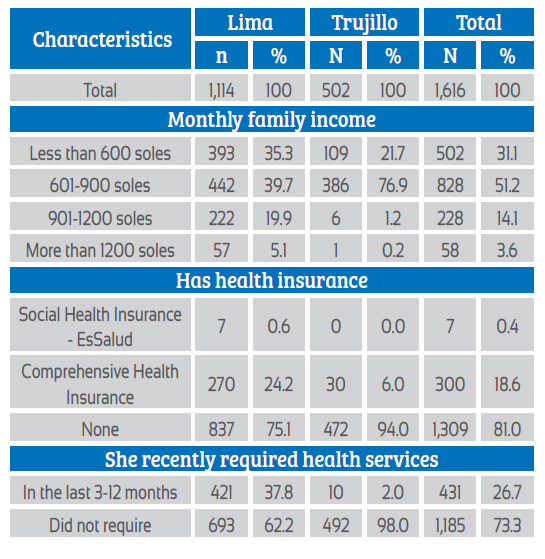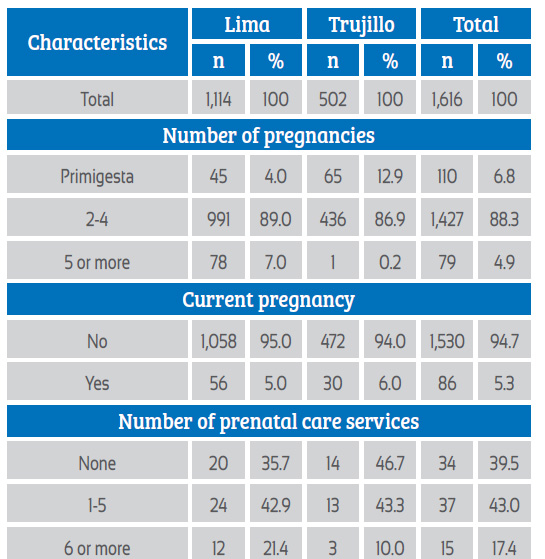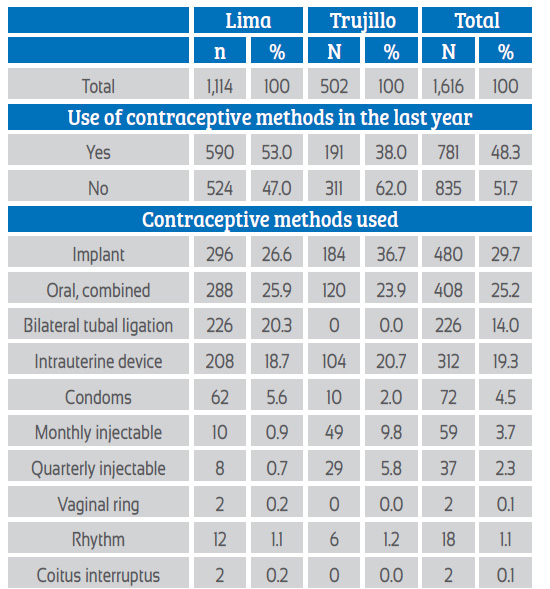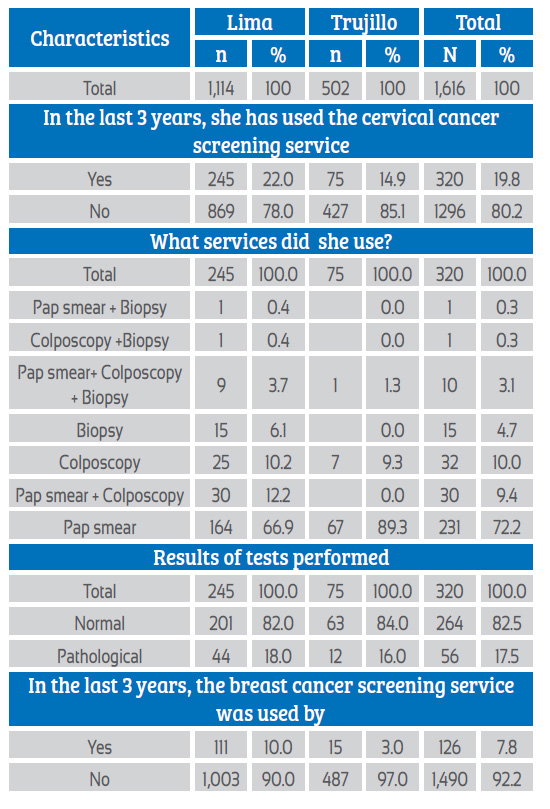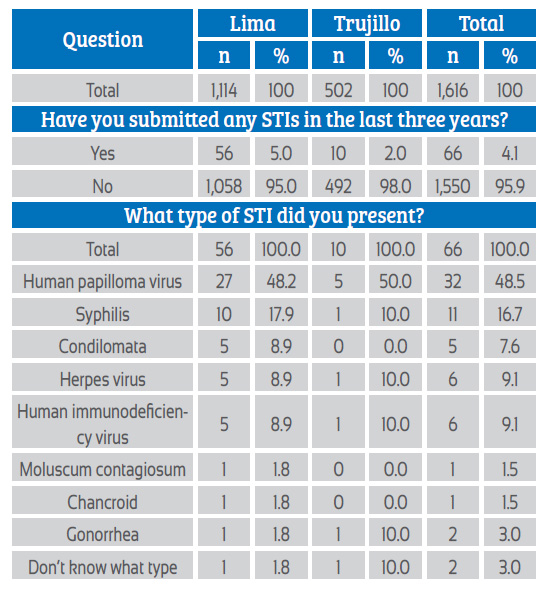Services on Demand
Journal
Article
Indicators
-
 Cited by SciELO
Cited by SciELO
Related links
-
 Similars in
SciELO
Similars in
SciELO
Share
Revista Peruana de Ginecología y Obstetricia
On-line version ISSN 2304-5132
Rev. peru. ginecol. obstet. vol.69 no.2 Lima Apr./Jun. 2023 Epub July 06, 2023
http://dx.doi.org/10.31403/rpgo.v69i2529
Original paper
Sexual and reproductive health needs of Venezuelan women migrants
1Médico Ginecólogo Obstetra Miembro del staff Clínica Santa Isabel de Lima-Perú, Director del Equipo Técnico Instituto de Salud Popular (INSAP) del Proyecto de la Fundación Panamericana para el Desarrollo (PADF), Maestro de la Ginecología y Obstetricia Latinoamericana (FLASOG), Miembro del Comité de la Federación Internacional de Ginecología y Obstetricia (FIGO) de Derechos Humanos, Refugiados y Violencia contra la Mujer, Past Presidente de la Sociedad Peruana de Obstetricia y Ginecología (SPOG).
2Médico Ginecólogo Obstetra Miembro del Equipo Técnico INSAP del PADF, Director de Investigación y Docencia Especializada del Instituto Nacional Materno Perinatal, Docente Universidad Nacional Mayor de San Marcos, Secretario General de la SPOG.
3Licenciado en Obstetricia, Miembro del Equipo Técnico del INSAP del PADF, Jefe Equipo Obstétrico Hospital Guillermo Kaelin, Lima, Perú.
Objective
: To determine the sexual and reproductive health needs of the Venezuelan migrant population residing in Lima and Trujillo.
Methods
: The sample consisted of 1,616 women, including 1,114 women from the southern cone of Lima and 502 women from the province of Trujillo. A survey was applied to evaluate the following dimensions: population characteristics, health service requirements, maternal health, family planning, cervical and breast cancer prevention, and sexually transmitted infections.
Results
: Most of the Venezuelan women were between 20-34 years old. They had an identity card in 66.8%; however, 60% of them did not have a valid document and more than 80% did not have their migratory status regularized. 46% were cohabiters and 40.8% were single. 56.7% reported having secondary education. 82.2% had a monthly family income of less than 900 soles; 75.1% in Lima and 94% in Trujillo reported not having any type of insurance. Only 48% used any contraceptive method, preferably long-acting reversible contraceptive methods. Between 78%85.1% did not use cervical cancer prevention services and more than 90% did not use breast cancer prevention services. Sexually transmitted infections were present in 2 and 5% of the surveyed population.
Conclusion
: The sexual and reproductive health (SRH) profile of the Venezuelan migrant population in the study areas had its own characteristics that was not comparable with the vulnerability of the Peruvian population, and reveals that they have SRH needs that require attention.
Key words: Venezuelan migrant population; Sexual and reproductive health profile; Need for care
INTRODUCTION
In our country, the increase in Venezuelan migration has been occurring since 2017; it is estimated that by 2022 the migrant population in Peru is greater than 1.5 million Venezuelan migrants1. Despite these approximately 7 years of migration, to date there is no adequate information on the reproductive health needs in the migrant population of Venezuelan origin in our country. In this context and within the framework of the project "Strengthening the quality of sexual and reproductive, maternal and child health care for Venezuelan migrants in Peru", developed by the Pan American Development Foundation (PADF) and the Institute of Popular Health (INSAP, for its acronym in English), a survey was conducted on sexual and reproductive health by interviewing migrant women of different ages in South Lima and Trujillo, in order to know what were the main problems in reproductive health they have been facing and some of the gaps in the response from the health sector.
METHODS
This is a descriptive, quantitative, non-experimental, cross-sectional research conducted between March 18 and July 31, 2021. The sample consisted of a total of 1,616 Venezuelan migrant women; 1,114 came from the districts of the southern cone of Lima (Villa María del Triunfo, Villa El Salvador and San Juan de Miraflores) and 502 from the province of Trujillo. The survey was designed by the team of the Instituto de Salud Popular (INSAP) and the Venezuelan associations of Lima and Trujillo and subsequently validated by expert judgment. The questionnaire included population characteristics, health service requirements, maternal health, cervical and breast cancer prevention, and sexually transmitted infections (STIs). The data were entered and coded in a database. The Statistical Package for the Social Sciences SPSS v26 was used for processing, generating the tables presented in the results section. With regard to ethical aspects, the survey form explained to the informants the nature of the document and the fact that they responded confirmed their voluntary acceptance.
RESULTS
During the study period, 1,616 migrant women of Venezuelan origin were selected for the research. Of these, 1,114 corresponded to the districts of Villa María del Triunfo, Villa El Salvador and San Juan de Miraflores and 502 women to the province of Trujillo in La Libertad.
Table 1 shows the age distribution according to life stages, with the highest frequency between 20-34 years of age, a range of 15-65 years and an average of 32 years.
Table 1 sociodemographic characteristics of the migrant population.
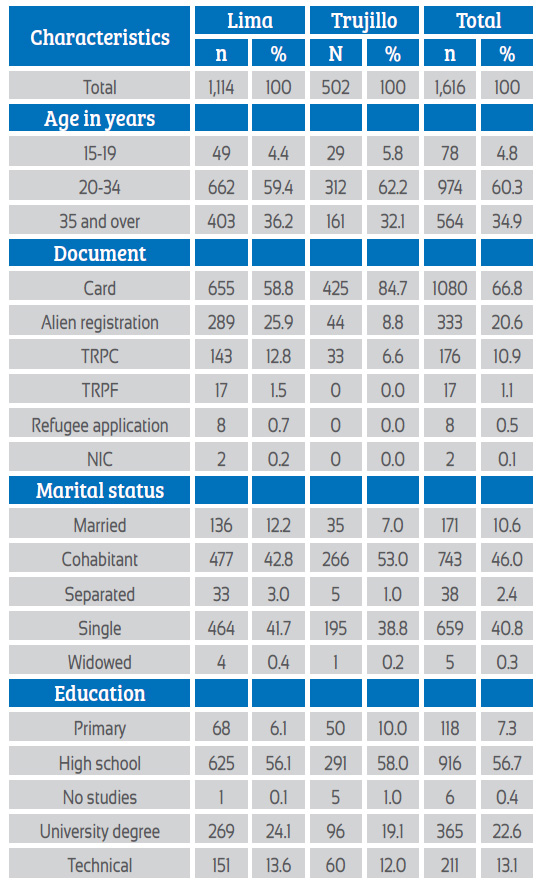
* TRPC= temporary residence permit card; trpf= temporary residence permit for foreigners; nic=national identity card
The largest number of women surveyed had an identity card (66.8%); however, 60% did not have a valid document and more than 80% had not regularized their migratory status.
By marital status at the time of the survey, 46% were cohabitating and 20.8% were single. 56.7% indicated that they had secondary education, 22.6% had university studies and 13.1% had technical studies.
As can be seen in Table 2, 82.2% of migrants had a monthly family income of less than 900 soles. When relating monthly income to age, it is evident that when they approach 40 years of age, they do not receive a monthly payment, i.e., they are not working. Likewise, the lower the income, the higher the health requirements.
When asked if they had insurance, 75.1% in Lima and 94% in Trujillo reported not having any type of insurance.
When asked about the number of pregnancies, all the women surveyed in Lima and Trujillo had had at least one pregnancy; the group of women who had had between 2-4 pregnancies was the most frequent, representing 88.3% (Table 3).
Of the women surveyed, 5.3% were pregnant at the time of the survey. Of these, 39.5% had not started any prenatal care. In response to the question "Where are you being monitored?", 61.4% said that they were being monitored at a primary care center (health center), 19.3% at a level III hospital and 8.8% in private practice.
Regarding family planning (Table 4), there was greater use of contraceptive methods in Lima (53%) than in Trujillo (38%). The most commonly used were long-acting contraceptive methods (LARC), such as subdermal implants (29.7%), intrauterine devices (19.3%), and bilateral uterine tubal ligation (14%).
Table 5 shows that between 78%-85.1% did not use cancer prevention services in the last three years. Of the total respondents, 245 (22%) and 75 (14.9%) in Lima and Trujillo, respectively, had a cervical cancer screening test; of these, 18% in Lima and 16% in Trujillo had a pathological result.
More than 90% did not use breast cancer prevention services.
Sexually transmitted infections (STIs) were present in 2-5% of the surveyed population, with human papillomavirus infection being the most frequent.
DISCUSSION
The political, social, and economic crisis in Venezuela has caused thousands of people to migrate to Peru since mid-20172). The Peruvian population grew by more than one million3). Some studies that evaluate the needs and demands of populations in different countries point out that the greatest challenges stem from limited medical care4), especially in reproductive health, with urban areas having the least access to these services. This situation is compounded by the problems faced by migrant populations in accessing services due to their migratory status4).
The vulnerability of the migrant population has its own characteristics that cannot be compared with the vulnerability of the Peruvian population. The reason for this assessment has allowed us to draw and/or come closer to having a profile of Venezuelan migrant women in the study area:
Migrant women were between 20-34 years of age (reproductive age). However, there was a significant percentage of women over 35 years of age, and these are the ones who require SRH services, increasing their vulnerability. There was a significant percentage of adolescents requiring services.
The migrants were cohabiting and single, with 2-4 children, secondary and higher education, income of less than 900 soles and more than 80% did not have health insurance. A cross check of income and health requirements showed that the lower the income, the higher the health requirements.
Between 5-6% were pregnant, and the majority of pregnant women used health services. Pregnant migrant women in our country have immediate access to comprehensive health insurance; however, a significant percentage did not use public services (accessibility, barriers, stigmatization).
Regarding family planning, they recognized the importance of unwanted pregnancy and used long-acting methods and combined contraceptive methods. However, a good number did not access services because they were not available on days and times outside the workday.
They represented an unprotected population with regard to early detection of cervical and breast cancer, many of them without access to these services.
There was a high incidence of human papillomavirus, so it is essential to think about preventive measures, as well as vaccinating daughters.
The problems of access to services increase according to the migratory situation.
CONCLUSION
The sexual and reproductive health profile of the Venezuelan migrant population in the study areas has its own characteristics, not comparable to the vulnerability of the Peruvian population, and shows that their sexual and reproductive health needs may vary according to their situation and context5). Migrants may face barriers in accessing health care services6). It is essential that health systems in receiving countries recognize and address these reproductive health needs of migrant women and their children7-10), providing culturally sensitive, accessible and quality services to ensure the well-being and reproductive autonomy of this population.
REFERENCES
1. Takehara J. El acceso a los derechos sexuales y reproductivos en mujeres migrantes. IDEHPUCP; 2021. [Acceso el 10 de noviembre 2022]. Internet. Disponible en: https://idehpucp.pucp.edu.pe/analisis1/el-acceso-a-los-derechos-sexuales-y-reproductivos-en-mujeres-migrantes/. [ Links ]
2. Konrad Adenaurg Stiftung. Migración venezolana. Oficina de la Fundación en Perú; 2021. [Acceso el 25 de mayo 2022]. Internet. Disponible en: https://www.kas.de/es/web/peru/statische-inhalte-detail/-/content/especial-migra-cion-venezolana-1 [ Links ]
3. González López JR, Rodríguez Gázquez MA, Lomas Campos MM. Salud Sexual y Reproductiva en inmigrantes latinoamericanos adultos de la ciudad de Sevilla. Enferm glob. [Internet]. 2013 Ene [citado 2023 Jun 23]; 12(29): 34-42. Disponible en: http://scielo.isciii.es/scielo.php?script=sci_art-text&pid=S1695-61412013000100002&lng=es [ Links ]
4. Organización Panamericana de la Salud. Línea de base de los problemas y necesidades de salud de las personas refugiadas y migrantes procedentes de Venezuela en Lima Metropolitana. Lima, Peru: OPS; 2022. [Acceso 10 mayo, 2023]. Disponible en: https://iris.paho.org/handle/10665.2/56311. [ Links ]
5. Mendoza W, Miranda JJ, Mendoza W, Miranda JJ. La inmigración venezolana en el Perú: desafíos y oportunidades desde la perspectiva de la salud. Rev Peru Med Exp Salud Publica. 2019 Sep;36(3):497-503. [ Links ]
6. Profamilia, Federación Internacional de Planificación Familiar. Evaluación de las necesidades insatisfechas en salud sexual y salud reproductiva de la población migrante venezolana en cuatro ciudades de la frontera colombo-venezolana: Arauca, Cúcuta, Riohacha y Valledupar. Bogotá, D.C.; 2019. [ Links ]
7. Caballero Guzmán A, Gonzales Sierra BL, Salazar Molina LV. Política en salud sexual y reproductiva en mujeres migrantes venezolanas en Colombia. Revista Estudios Culturales. 2021;14(27):39-50. [ Links ]
8. Mendoza W, Miranda JJ. La inmigración venezolana en el Perú: desafíos y oportunidades desde la perspectiva de la salud [Venezuelan immigration in Peru: challenges and opportunities from a health perspective]. Rev Peru Med Exp Salud Publica. 2019;36(3):497-503. doi:10.17843/rpmesp.2019.363.4729 [ Links ]
9. Blukacz A, Carreño Calderon A, Obach A, Cabieses B, Peroncini J, Oliva A. Perceptions of Health Needs among Venezuelan Women Crossing the Border in Northern Chile during the COVID-19 Pandemic. Int J Environ Res Public Health. 2022;19(22):15175. Published 2022 Nov 17. doi:10.3390/ijerph192215175 [ Links ]
10. Vargas-Machuca R, Rojas-Dávila CE, Jiménez MM, Piscoya-Magallanes CR, Razuri H, Ugaz ME. Situación nutricional de los niños migrantes venezolanos a su ingreso al Perú y las acciones emprendidas para proteger su salud y nutrición [Nutritional situation of Venezuelan migrant children upon entry into Peru and the actions taken to protect their health and nutrition]. Rev Peru Med Exp Salud Publica. 2019;36(3):504-510. doi:10.17843/rpmesp.2019.363.4676 [ Links ]
Financing: Pan American Development Foundation (PADF), Strengthening the Quality of Maternal and Infant Care for Venezuelan Migrants in Peru Project
Received: June 22, 2023; Accepted: June 28, 2023











 text in
text in 


